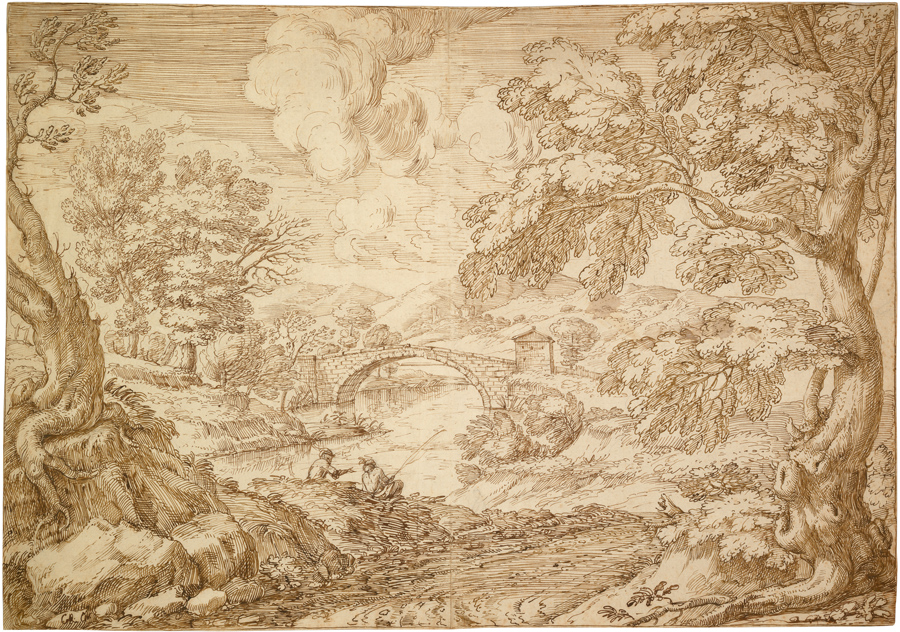Loading the page ...
Crescenzio Onofri
(ca. 1632 Rome – after 1712 Florence)
A Wide Wooded Landscape with Two Anglers on a River Bank. Pen and brown ink, borderline in brown ink. 41.4 x 59 cm. Monogrammed at bottom left: CR. ON.
Thanks to the research carried out by Marco Chiarini we know quite a lot about the biography and artistic career of the landscape painter and etcher Crescenzio Onofri. Born in Rome about 1632, the artist was the only pupil of Gaspar Dughet, to whose landscape style he remained true all his life. In 1689, Onofri was appointed court painter to Grand Duke Cosimo III de’ Medici in Florence, where he became a prolific landscape painter. Some of his works were the result of collaboration with figure painters such as Antonio Giusti, Pier Dandini, Francesco Petrucci and, not least, Alessandro Magnasco from Genoa, all of whom were responsible for providing the staffage (see Marco Chiarini, "Crescenzio Onofri a Firenze", Bollettino d’Arte, 52, 1967, pp. 30–32).
Onofri’s status as one of the most important representatives of the "classicismo dughettiano" (Chiarini) is due not only to his talents as a landscape painter but also as a gifted draughtsman and etcher. While the early drawings are mainly executed on a small scale using a precise technique, the late Florentine period saw the production of a number of grandiose landscape drawings which are distinguished by an extraordinarily dynamic and powerful style of drawing. At an advanced age Onofri demonstrated in these works a truly sovereign mastery of his medium and a painterly freedom which also came to typify his late landscapes. Stylistically the present work fits in seamlessly with a set of eight large-format landscape drawings, which in 1713 were in the collection of the Principe Ferdinand of Tuscany and in whose inventory they were described as otto disegni in penna di paesi in carta imperiale. Today the works, monogrammed "CR" or "CRO" are to be found in the Uffizi Gallery in Florence (see Marco Chiarini, I Disegni Italiani di Paesaggio dal 1600 al 1750, Treviso 1972, pp. 58–59, fig. 108). Our drawing shows Onofri’s typical use of large, bizarrely twisted and windblown trees in the foreground, which serve as a repoussoir and provide a frame for the landscape scenery; the gnarled, weather-beaten trunks have an almost arcimboldesque appearance. The pen is wielded with an unusual verve that is almost impetuous; powerful hatching patterns dashed off without apparent effort achieve a maximum of plasticity and chiaroscuro effect. The stone bridge in the middle of the picture and the hilly landscape on the horizon, on the other hand, are drawn in more delicate lines. The clouds looming ominously in the sky are convincingly rendered. Nature seems to be stirred up by an inner unrest, as though a raging storm might break out at any moment; however the two anglers, slightly to the left of centre, pursue their activity in apparent oblivion.
